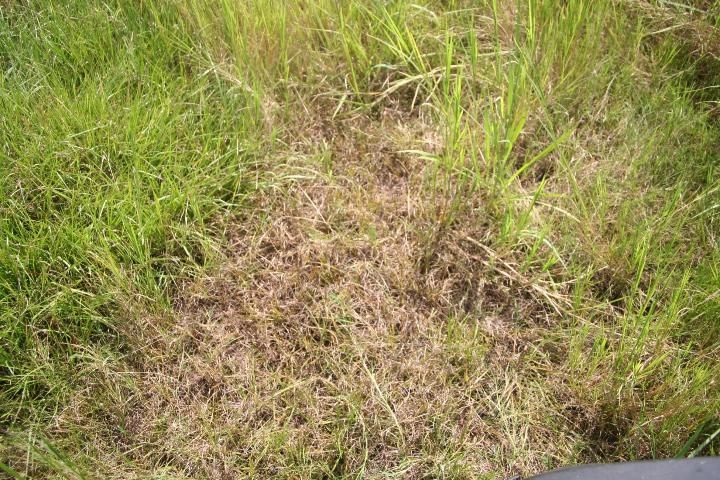Introduction
Bahiagrass is the most common forage grown in Florida. This forage is present on approximately 2.5 million acres in Florida. The popularity of bahiagrass in this state can be attributed to its drought tolerance, low fertility requirements, and persistence even under heavy grazing.
Although bahiagrass is an important forage species, it can be a serious weed problem for those wishing to produce high-quality bermudagrass hay. However, bahiagrass typically does not invade a healthy bermudagrass sward. As a bermudagrass stand begins to thin, and nutrients—such as nitrogen—become limiting, bahiagrass invasion is common. Additionally, a small percentage of bahiagrass seed can remain in the soil for several years. A healthy bermudagrass sward is necessary to prevent bahiagrass establishment, but herbicides can be used successfully if bahiagrass encroachment begins.
Prevention
Bahiagrasses do not tolerate shade. Therefore, maintaining a good bermudagrass, stargrass, or limpograss stand is one way to prevent bahiagrass invasion. (For specific recommendations concerning management practices for bermudagrass cultivars, see EDIS Publication SS-AGR-60, Bermudagrass Production in Florida, https://edis.ifas.ufl.edu/aa200.)
In addition to maintaining a good stand, prevent movement of bahiagrass seeds into a pasture, clean hay equipment and do not feed bahiagrass in these pastures. Because bahiagrass tends to tolerate stresses, such as drought and insect pressure, bahiagrass invasion may occur when such conditions are prevalent.

Credit: B. Sellers, UF/IFAS
Chemical Control
Metsulfuron-methyl. Several herbicides available on the market contain metsulfuron-methyl (Table 1). The label for each specific product contains detailed instructions for control of Pensacola bahiagrass. In general, for optimum control of bahiagrass, these herbicide products need to be applied after full greenup but before seedhead formation. See the label for specific instructions for adjuvant use. Metsulfuron efficacy under dry conditions tends to be lower than when rainfall is adequate.
It has been our experience that long-term control of bahiagrass with products containing metsulfuron-methyl is rarely attainable. Some of our recent research has demonstrated that metsulfuron provides up to 90% control of Pensacola bahiagrass, but it tends to regrow over time. Additionally, including 2,4-D with metsulfuron ultimately results in less bahiagrass control. Therefore, if one of the products listed in Table 1 is used, the product will likely need to be applied annually to suppress bahiagrass during the growing season to allow for good production of bermudagrass or stargrass hay. Additionally, metsulfuron provides very little suppression of Argentine, Paraguayan, and Common bahiagrass cultivars.
Chaparral. Control of bahiagrass with Chaparral—a premix of Milestone + Cimarron—is similar to control achieved with other metsulfuron-methyl containing products. The application rate of Chaparral for Pensacola bahiagrass control is 2.0–2.5 oz/acre. This amount of Chaparral will provide results similar to those listed in Table 1. However, long-term control with Chaparral will rarely be attainable, and annual applications will likely be needed to suppress bahiagrass. Additionally, Argentine bahiagrass will not be controlled by Chaparral.
Impose/Panoramic. Impose and Panoramic are two products that contain imazapic, the active ingredient in Plateau. These two products can be used for bahiagrass control, but the amount of kill is directly rated to the amount of herbicide used. The labels recommend 6–8 oz/acre of Impose/Panoramic for bahiagrass control. In addition to bahiagrass control, these products also control crabgrass, signalgrass, barnyardgrass, vaseygrass, and sandbur. The downside to these products is that they tend to cause more bermudagrass and stargrass injury than has been observed with use of Cimarron Plus or Chaparral. However, limpograss is the most tolerant forage of the three to imazapic.
Impact of Herbicide Applications on Forage Yield
Herbicides listed in Table 1 will not cause any injury to bermudagrass or stargrass varieties. Impose/Panoramic will cause some injury to both bermudagrass and stargrass, but very little to limpograss. Despite reports that some varieties of these grasses are more sensitive, we have not conducted such research under Florida growing conditions. However, it can be reasonably expected that broadcast applications of these three herbicides will result in some initial forage-yield loss. Nonetheless, forage yield will recover over time, and fertilization may aid in recovery. (For more on pasture fertilization, see EDIS Publication SL129, UF/IFAS Standardized Fertilization Recommendations for Agronomic Crops, https://edis.ifas.ufl.edu/ss163.)
Herbicides that contain metsulfuron-methyl and their suggested rates of application for bahiagrass suppression in bermudagrass and stargrass pastures.
How to Reduce Forage-Yield Loss Associated with Impose/Panoramic
If a broadcast application of these herbicides is made to actively growing bermudagrass or stargrass, yield reductions are likely to occur. One way to reduce such yield loss is to apply the herbicides soon after cutting for hay. In most cases, weedy grasses will resume growth before the bermudagrass or stargrass. In research and demonstration plots at the UF/IFAS Range Cattle Research and Education Center in Ona, FL, applications of these herbicides between 7–10 days after cutting reduced forage-yield loss compared to broadcast applications to actively growing bermudagrass and stargrass.